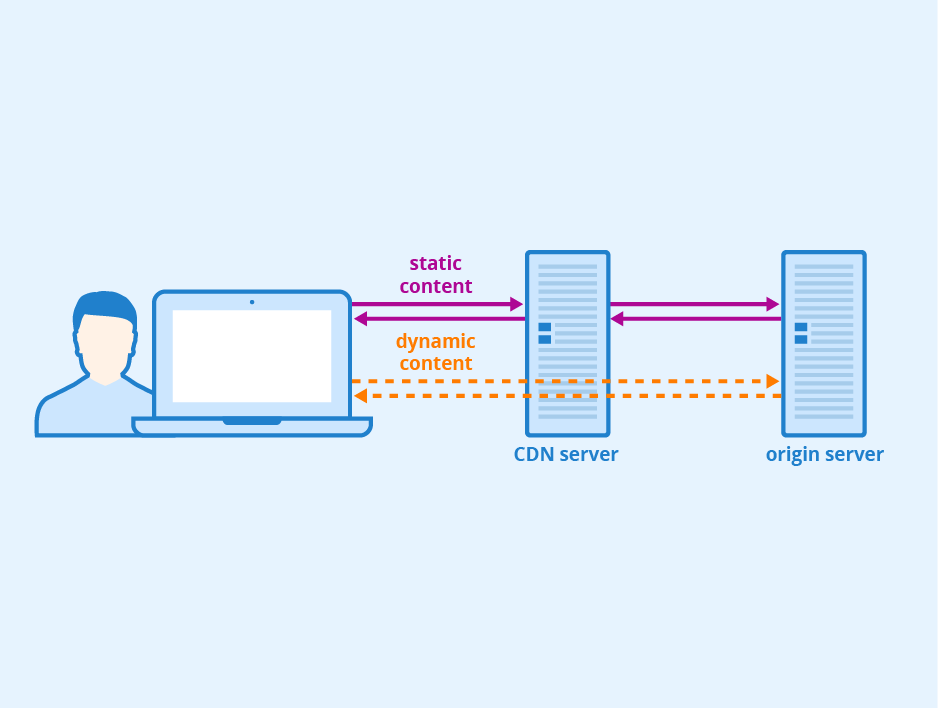As a website owner, it can be difficult to maintain a competitive edge over others. Slow loading times, long bouts of downtime, and a lack of security can push visitors to leave your site and go elsewhere.
Fortunately, using a Content Delivery Network (CDN) is a great way to optimize your web performance. Not only can it boost speeds, but you can enjoy greater security, improved stability, and lower bandwidth costs.
In this post, we’re going to answer the question, “what is a CDN?”. Then, we’ll explore some of the ways that a CDN network can improve your website. Let’s get started!
What Is a CDN?
A Content Delivery Network (CDN) is a group of distributed servers designed to speed up content delivery. CDNs can’t host content, so they won’t replace your web host. Instead, a CDN can stabilize your website and boost its performance:

A CDN network is effective because it reduces the proximity between your users and your server.
For instance, your web host’s servers may be dotted around the U.S. So, when a European visitor comes to your website, the content can take a while to load. However, with a CDN, you can serve your website’s content from a European server, drastically cutting down on loading times.
CDN technology was initially intended to reduce latency (the delay you experience before your content fully loads). Therefore, as a way to maintain efficient website performance, the first CDN was launched by Akamai in 1998.
At first, the focus revolved around static content like software downloads and video streaming. Now, CDN servers allow you to deliver far more complex, dynamic content to users worldwide.
CDN vs Web Host vs Cloud
While a CDN can cache content to boost performance, it can’t host content. That’s a job for a web hosting provider.
Think of it like this — your web host is a necessity. You can’t manage a website without one. But a CDN is a bonus that adds more speed, stability, and security.
It’s also easy to confuse CDN technology with cloud computing since they both improve performance and enable scalability. However, as we discussed earlier, CDNs can’t host applications, whereas there are plenty of cloud hosting providers:

Additionally, a CDN is focused on speed, but cloud computing is more suited to scalability. What’s more, a CDN has servers distributed all over the world, but cloud computing aims to completely remove geolocation from the equation.
Who Uses a CDN?
Many large websites rely on CDNs, such as Netflix, Facebook, and Amazon. In fact, out of the top 1 million websites, almost 46 percent use a CDN to serve content.
That’s why, without knowing it, you’ve probably used a CDN when going about your usual online activity. For example, CDNs are used by e-commerce websites to speed up transactions. Meanwhile, you may have encountered a CDN while streaming a movie, checking your bank balance, or booking a vacation.
In fact, for any website visited by users all over the globe, a CDN is one of the easiest ways to ensure smooth, reliable performance. It can help you improve user experience (UX) and reduce abandonment rates.
Better yet, the possibilities are almost endless since you can serve up so many different kinds of content with a CDN. You can deliver HTML pages, JavaScript files, stylesheets, images, and videos. On the client side, visitors can use a CDN to live-stream media, download files, and load scripts.
The Benefits of Using a CDN
Now that we’ve answered the question “what is a CDN” let’s look at the main benefits of using one!
Reduce Load Time
The main benefit of using a CDN is reducing website loading times. This has other advantages besides faster performance. For instance, the bounce rate increases by 32 percent once the load time goes from one to three seconds.
Therefore, a CDN is a great way to reduce bounce rates and increase time on site. In turn, you may be rewarded with higher search rankings.
Minimize Downtime
A CDN is also an excellent way to increase stability on your site. Without a CDN network, the availability of your website is entirely dependent on your web host’s server. If your server gets attacked, your website goes down. Not only does this mean you’ll lose traffic and revenue, but it can also damage your reputation.
With a CDN, you’re able to minimize downtime by having extra servers that you can call on. If your web server becomes compromised, you can continue serving content through your CDN servers. Even if one of your servers goes down, you still have others that you can rely on.
This also means you’re more equipped to handle sharp traffic spikes that can overwhelm your hosting server. Plus, you can make your site more resilient to hardware failures.
Better Data Security
As we discussed in the previous section, a CDN can stabilize your website. This puts you in a better position to deal with certain online attacks.
For instance, Distributed Denial of Service (DDoS) attacks occur when your website gets flooded with requests that eventually overwhelm your server and break your site. Since you have additional servers at your disposal, you will be able to withstand the high influx of requests designed to take your site offline.
Moreover, with certain CDN providers, you might also enjoy other security enhancements like Web Application Firewalls (WAFs). Additionally, you’ll be able to improve your security certificates and generate secure tokens with expiry times.
Lower Bandwidth Expenses
Lastly, using a CDN is an easy way to lower bandwidth costs. This is because a CDN utilizes caching and other optimizations to reduce the data your server needs to provide. Therefore, it lowers your bandwidth usage and, in turn, reduces your hosting costs. On top of that, CDNs help offload CPU and other resources from your hosting server.
How Does a CDN Work?
Now that you know the benefits of using a CDN let’s take a closer look at how CDN technology works.
Improve Loading Times
A CDN has servers placed at strategic locations to boost connectivity. They are often at the exchange points between networks where different Internet providers connect. Since the CDN has access to these high-speed locations, it can deliver data quickly at low costs.
A CDN can also improve loading times because there’s physically less distance between users and your website resources. Plus, CDNs use optimizations like minification and file compression to reduce the amount of data that is delivered. For sites using SSL or TLS, CDNs also optimize connection reuse and enable TLS false starts.
Stabilize Web Performance
As we mentioned earlier, using a CDN is a great way to stabilize your application. You can use it to improve your uptime, ensuring availability and access to your website.
Frequent downtime is often the result of a poor-quality host. In this instance, your servers can’t handle lots of traffic or withstand traffic-induced attacks like DDoS.
Additionally, with a poor hosting provider, the quality of your hardware is often substandard. Therefore, your site might be vulnerable to long bouts of downtime, missing out on visitors and sales.
What’s more, CDNs are able to stabilize your web performance by load balancing. Load balancing is when traffic is distributed evenly across your servers. Therefore, if one server goes down, your CDN can easily redistribute traffic to another.
In fact, some CDN providers can even route traffic to a whole other data center in the unlikely event that every server on the network becomes compromised.
Increase Data Security
Data security should be a prime concern for any website that deals with personal information like credit card details and email addresses. Fortunately, a CDN is a great way to tighten up your security measures.
Firstly, a CDN can secure your website with optimized TLS and SSL certificates. These follow a high standard of authentication and encryption, so any data exchanged on your site is kept safe and secure.
Additionally, some online attacks, such as DDoS and brute force attacks, rely on overwhelming your website with traffic. If successful, hackers can then implement malware infections. Since a CDN enables your site to handle high volumes of traffic, it is less susceptible to threats of this nature.
How Is the CDN Cache Updated?
CDNs utilize caching for efficient content delivery. Caching is a process that stores copies of your files, enabling users to access your content quickly. Without caching, the content is loaded from your server every time, resulting in long wait times as a connection is established.
Better yet, a CDN can cache almost any content, such as web pages, images, and videos. The files are usually held in proxy servers close to the user’s location. This way, your visitors can go about their web activities without waiting for a connection to be made.
Then, the cache remains on your CDN server for other users to request within the same geographical area. If the content requested is unavailable or outdated, the CDN will store a fresh copy of the content for future use.
Do You Need a CDN for Your Website?
Using a CDN is a great way to exceed the limits of your web host. Rather than relying on your host’s limited resources, you can run a faster website with greater stability.
Better yet, a CDN is multi-purpose. Of course, if you’re looking for a way to boost loading times, you might implement a caching plugin. Or, if security is more important, you can invest in a malware scanner or a WAF.
However, with a CDN, you can cover all bases: performance, security, and stability. Not only can it improve your UX, but it can also better protect your website and visitors.
How Can Kinsta Help?
At Kinsta, we provide full access to a Cloudflare CDN. Cloudflare is an industry leader in web performance. Its CDN can block malicious traffic, cache static files, optimize images, and more.
It doesn’t matter which Kinsta plan you have; you can easily integrate your website with Cloudflare. Then, you will benefit from a secure firewall, DDoS protection, and wildcard SSL certificates. Better yet, it’s super simple to get started with Cloudflare integration:

Moreover, since 2022, you can take full advantage of Edge Caching, Kinsta’s newest feature. Edge Caching dramatically reduces the time it takes to deliver your web pages to users worldwide. This feature is available to all Kinsta customers and includes mobile caching.
Summary
Rapid technological advancements can make it difficult to ensure that your website keeps up. If it doesn’t, you might experience high bounce rates, reduced time on site, and lower search rankings.
Fortunately, you can use a CDN to deliver content at a much quicker rate than your web host. What is a CDN? The short answer is that using a CDN is a great way to stabilize your performance, knuckle down on security, and improve your UX.
Kinsta’s CDN is built with performance in mind. With any of our plans, you’ll get access to our Cloudflare-powered CDN at no extra cost. With over 257 PoPs, it can reduce page load time by up to 44 percent worldwide. Check out our plans today to get started!


